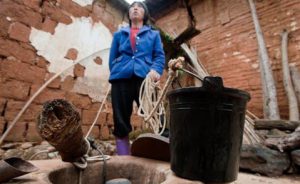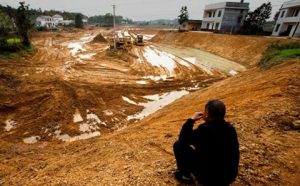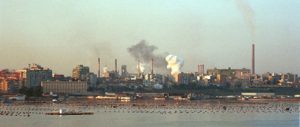On February 14, former and current residents of Love Canal, near the world-famous Niagara Falls in the state of New York, filed 15 new lawsuits against the city government and the companies responsible for containing and cleaning up the toxic mess that has plagued the neighbourhood. The total number of plaintiffs now stands at exactly 1,000, and the range of health issues they allege is daunting: crumbling teeth, heart problems, birth defects and cancer.
“I’ve been working with a lot of the people that are currently affected,” says Luella Kenny, a former Love Canal resident turned environmental activist, “and I see a lot of similarities.” Kenny is referring to the events of 1977 and 1978, when snowmelt from an unusually brutal winter seeped into the buried 16-acre canal, causing toxic chemicals to enter the groundwater and bubble up to the surface, then into basements and yards. Between 1942 and 1953, the Hooker Chemical Company, later bought by the oil and gas giant Occidental Petroleum, had dumped nearly 22,000 tonnes of hazardous chemical waste into an abandoned old canal. Filled in and covered over, the resulting landfill looked like any other grassy field, and a whole residential neighbourhood had been developed on top of it: some 800 family homes and 240 apartments, with an elementary school right at its heart.
Residents like Kenny moved in having no idea the chemicals were there. Her 7-year-old son died of kidney disease in 1978, the same year that state and federal politicians declared Love Canal a disaster area and evacuations began. The winter of 1977-78 wasn’t the first time residents had experienced the toxicity right beneath their feet, but the resulting revelations about the extent of the pollution and the severe health problems among residents prompted a national outcry. Love Canal became an infamous symbol of America’s pollution problem and the devastating direct effects it could have on ordinary people—and then a lightning rod for the new environmental movement.
Love Canal was far from unique as a site of unrestored environmental degradation in a residential neighbourhood—what made it different was the relentless activism of its residents, including Lois Gibbs, an activist who now runs the non-profit Center for Health, Environment & Justice.
“The only way to win justice,” says Gibbs, “is by people standing up and speaking out.” Besides drawing the media spotlight, Love Canal residents became seasoned, well-organised activists almost overnight, directly confronting powerful corporate and government figures who denied the problems even existed. Theirs is very much the kind of story portrayed in the movie Erin Brockovich, concerning a similar case in California which also refuses to go away.
Following the evacuation, clean-up crews built a chain-link fence 10 feet high around the 40-acre containment area, a drainage trench around the canal itself (connected to a pump and treat system), and a supposedly impermeable clay cap on top. According to Gibbs and many current residents, it simply hasn’t worked: the buried canal is connected to the adjacent Niagara River, with which it rises and falls seasonally. Moreover, says Gibbs, “they did nothing, absolutely nothing, to remove the contaminants that were throughout the neighbourhood”—in yards and in basements, permeating the soil.
Occidental paid several hundred million dollars in clean-up costs and damages, while government managed the process. According to a spokesman for New York’s Department of Environmental Conservation, “The remedial system in place is working correctly and as designed, and is monitored regularly to ensure effectiveness.”
In the 1990s, a section of Love Canal once called uninhabitable was reopened under the name Black Creek Village, and new residents started moving in. The first group was aware of the issue, but Kenny says that signs indicating a hazardous area were subsequently taken down. Kenny points to a family that moved in one block from the former evacuation area, unaware that Love Canal even existed, until a child they had was born with severe chromosome damage and numerous other physical problems. Chemicals are being found in people’s yards, and many of the new residents are noticing troubling health patterns like those that came before, though proving direct causation (as opposed to “reasonable association”) remains challenging in the complex field of public epidemiology.
Superfunds and the US clean-up plan
The resurfacing of problems at Love Canal may be a bellwether, just as its problems were in the 1970s. “We were the first of thousands of sites across the country,” says Gibbs, “and there was a recognition that the cost of fixing these problems is prohibitive… billions and billions and billions of dollars.” At the time, the public furor was such that vital steps were at least taken in the direction of fixing things, with the creation in 1980 of the federal Superfund programme, which designated a pool of money to remediate toxic sites where the polluter was unknown or incapable of cleaning up. Until it was allowed to expire by a Republican-led Congress in 1995, a special tax funded the programme, paid by oil, gas, and chemical companies, the principal polluters.
Today there are over 1,300 “Superfund sites” recognised by the federal government—though seen by some as a stigma, the label is supposed to mean that help is on the way. The Environmental Protection Agency, which runs the programme on just US $1.2 billion a year (now out of general tax revenues), says that 375 sites (including Love Canal) have been fully cleaned up and deleted from the list and that significant fixes are in place at most others. Half of all Americans live within 10 miles of a Superfund site, according to a government estimate in 2000, and remediated sites can end up as offices, commercial sites, or even residential neighbourhoods like “Black Creek Village”.
Initially seen as effective, the Superfund programme is now under fire from environmentalists. Without significant funding, says Gibbs, “it’s just barely limping along” and the identification of new sites has slowed considerably—indeed, there are thousands of “brownfield” sites across the country that are just as polluted, but languish from lack of attention. A recent study by The Guardian and The Center for Investigative Reporting found that Superfund sites have “their own legacy of unintended consequences”, between their environmental footprint (which the EPA has only recently started measuring) and the increasing amount of waste they produce (even as its toxicity is reduced).
The report highlighted the one-third of all Superfund sites where the groundwater is polluted with volatile organic compounds, as at Love Canal, saying that the programme at its worst is “a shell game in which one environmental danger appears to be addressed, yet is moved somewhere else in the form of a new problem.” In some cases, real restoration of a site may involve more money, longer periods of time, and harder choices than many people are willing to swallow. Across America, a question mark now hangs over the legacy of Love Canal.



